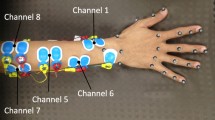Abstract
This paper deals with characterization and modelling of human handwriting motion from two forearm muscle activity signals, called electromyography signals (EMG). In this work, an experimental approach was used to record the coordinates of a pen tip moving on the (x, y) plane and EMG signals during the handwriting act. The main purpose is to design a new mathematical model which characterizes this biological process. Based on a multi-model approach, this system was originally developed to generate letters and geometric forms written by different writers. A Recursive Least Squares algorithm is used to estimate the parameters of each sub-model of the multi-model basis. Simulations show good agreement between predicted results and the recorded data.




















Similar content being viewed by others
References
Jacob S (2007) Human anatomy: a clinically-orientated approach. Scientific American, New York
Viviani P, Terzuolo CA (1983) The organization of movement in handwriting and typing. Lang Prod 2:103–146
Benrejeb M, El Abed-Abdelkrim A, Bel Hadj Ali S, Gasmi M (2003) A neuro-fuzzy internal model controller for handwriting process. In: CESA multiconference, Tokyo
Van Der Gon D, Thuring JP, Strackee J (1962) A handwriting simulator. Phys Med Biol 407–414
Mac Donald JS (1964) Experimental studies of handwriting signals. Ph.D. Dissertation. Massachusetts Institute of Technology. Cambridge MA
Yasuhara M (1975) Experimental studies of handwriting process. Rep Univ Electro-Commun 5(2):233–254
Manabu S, Kosaku T, Murata Y (2003) Modeling of human handwriting motion by electromyographic signals on foream muscles, CCCT conference, Orlando-Florida
Benrejeb M, Sano M, El Abed-Abdelkrim A (2001) Conventional and non conventional models of the handwriting process: differential, neural and neuro-fuzzy approaches. TIWSS 1:46–50 Tokyo
Benrejeb M, El Abed-Abdelkrim A (2002) Neuro-fuzzy model of the handwriting process, ICSDS conference, peking, pp 157–160
Plamondon R (1995) A kinematics theory of rapid human movements. Part II : Movement time and control. Biol Cybern 72:309–320
Chihi I, Abdelkrim A, Benrejeb M (2012) Analysis of handwriting velocity to identify handwriting processs from electromyographic signals. Am J Appl Sci 9(10):1742–1756
El Anes A, Bouzrara K, Garna T, Messaoud H (2013) Expansion of MIMO ARX model on Laguerre orthonormal bases, ICEESA conference, pp 1–6
Qi W-M, Xiao J (2013) Fuzzy predictive control for a tubular heat exchanger system based multiple models strategy. IHMSC Conf 1:220–223
Kukolj D, Levi E (2004) Identification of complex systems based on neural and Takagi-Sugeno fuzzy model. IEEE Trans Syst Man Cybern Part B 34(1):272–282
Chadli M, Borne P (2012) Multimodèles en automatiques: outils advances d’analyse et de synthèse, Ed. Hermes
Tutunji T, Molhim M, Turki E (2007) Mechatronic systems identification using an impulse response recursive algorithm. Simul Model Pract Theory 15:970–988
Djigan VI (2006) Multichannel parallelizable sliding window RLS and fast RLS algorithms with linear constraints. Int J Adapt Control Signal Process 86:776–791
Ding F, Ding J (2010) Least squares parameter estimation for systems with irregularly missing data. Int J Adapt Control Signal Process 24(7):540–553
Han LL, Sheng J, Ding F (2009) Auxiliary model identification method for multi-rate multi-input systems based on least squares. Math Comput Model 50(7/8):1100–1106
Ding F, Shi Y, Chen T (2007) Auxiliary model based least squares identification methods for Hammerstein output error systems. Syst Control Lett 56(5):373–380
Ding F (2012) System identification. Part F: Multi-innovation identification theory and methods. J Nanjing Univ Inf Sci Technol Nat Sci Ed 4(1):1–28
Liu D (2010) System identification methods and applications. National Defense Industry Press, Beijing
Platzer W (2004) Color Atlas of human anatomy: locomotor system, 5th edn, vol 1
Meulenbroek RGJ, Thomassen AJWM (1991) Stroke-direction preferences in drawing and handwriting. Hum Mov Sci 10:247–270
Narenda K-S, Balakrishman J (1997) Adaptive control using multiple models. IEEE Trans Autom Control 42:171–187
Elfelly N, Dieulot J-Y, Borne P (2008) A neural approach for multimodel representation of complex processes. Int J Comput Commun Control 3(2):39–50
Elfelly N, Dieulot J-Y, Benrejeb M, Borne P (2010) A new approach for multilmodel identification of complex systems based on both neural and fuzzy clustering algorithms. Eng Artif Intell 23(7):1064–1071
Acknowledgments
The authors wish to thank Professor Rentschler (LMU, Munich) for constructive criticism.
Author information
Authors and Affiliations
Corresponding author
Rights and permissions
About this article
Cite this article
Chihi, I., Abdelkrim, A. & Benrejeb, M. Multi-model approach to characterize human handwriting motion. Biol Cybern 110, 17–30 (2016). https://doi.org/10.1007/s00422-015-0670-6
Received:
Accepted:
Published:
Issue Date:
DOI: https://doi.org/10.1007/s00422-015-0670-6




